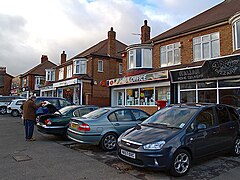Nunthorpe
| Nunthorpe | |
|---|---|
 Nunthorpe shops |
|
| Nunthorpe shown within North Yorkshire | |
| Population | 4,866 (2011.Civil Parish & Ward) |
| OS grid reference | NZ532151 |
| Unitary authority | |
| Ceremonial county | |
| Region | |
| Country | England |
| Sovereign state | United Kingdom |
| Post town | MIDDLESBROUGH |
| Postcode district | TS7 |
| Dialling code | 01642 |
| Police | Cleveland |
| Fire | Cleveland |
| Ambulance | North East |
| EU Parliament | North East England |
| UK Parliament | |
Nunthorpe is an outer suburb of the town of Middlesbrough, England. Historically part of the North Riding of Yorkshire, Nunthorpe is served by Nunthorpe and Gypsy Lane railway stations, both of which are on the Esk Valley Line from Middlesbrough to Whitby. The railway line here forms the boundary between the boroughs of Middlesbrough and Redcar and Cleveland, both of which are unitary authorities and are associated with the county of North Yorkshire for ceremonial purposes. Nunthorpe civil parish is west of the railway line, in Middlesbrough, whilst the area east of the railway line forms part of the Ormesby ward of Redcar and Cleveland.
The history of Nunthorpe can be traced back to before the Domesday Book of 1086. The village was named “Thorpe”, or “Torp” (words meaning settlement) in the Domesday Book and described as a thriving settlement, Nunthorpe consisted of an estimated 1,080 acres of land. Towards the end of the 12th century a group of Cistercians nuns, allegedly evicted from nearby Hutton Lowcross for rowdy behaviour, were resettled at Thorpe having been given some land there belonging to Whitby Abbey, on which they built a priory and mill. The nuns only stayed at Thorpe a few years, but their short stay resulted in Thorpe being renamed Nunthorpe. During the following centuries, Nunthorpe remained an agricultural community closely linked to the market towns of Stokesley and Ayton. The Industrial Revolution had very little impact on its agricultural economy.
Nunthorpe Hall is the ancient manor house in Nunthorpe village. It was built in 1623, and largely rebuilt and extended in around 1800 and altered again in the mid-1800s. The entrance porch and was added in 1901. The building was converted into a retirement home for the elderly in 1951. The main building is of dressed sandstone, with Lakeland slate roofs, with stone ridge copings. It became a Grade II, listed building, in 1952.
...
Wikipedia

